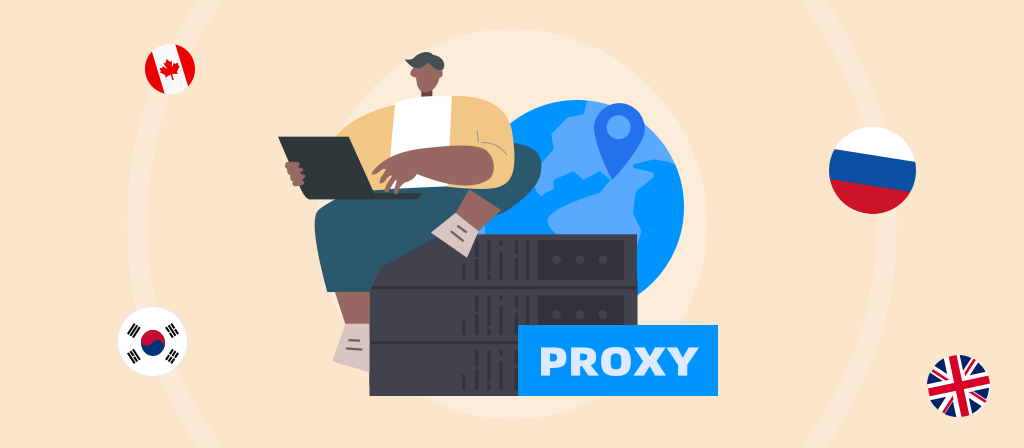When we need to browse the web securely, we often need to use a proxy. Proxies are divided into forward proxies and reverse proxies, but how do you know which one to use? After all, both sit between the client and the server. But their roles are opposites – knowing when to use one over the other is crucial.
This article covers the main differences between forward and reverse proxies, how each works, use cases, and how they relate to modern proxy services you probably use every day.
What Is a Proxy Server?

To grasp the concept of proxy vs reverse proxy, we must start with the basics.
A proxy server (also called a forward proxy) is a middleman between a client (usually a user’s device) and the internet. When you send a request, it goes to the proxy first, which then forwards it to the internet. The server you’re accessing sees the proxy’s IP address, not yours.
This is a popular way to:
- Mask your IP address
- Bypass geo-restrictions
- Block malicious content
- Monitor or control employee traffic (in corporate settings)
Forward Proxy in Action
Imagine you’re browsing the web from your school or office. The network might use a forward proxy to control which sites you can access or to cache frequently visited content for faster loading.
This is where the forward proxy vs reverse proxy distinction begins: the forward proxy works on behalf of the client.
What Is a Reverse Proxy?

A reverse proxy operates on the other side of the equation. Instead of hiding the client’s identity, it hides the server’s identity.
When a client (you) requests content from a website, the reverse proxy receives the request first. It then passes it to the correct server behind the scenes, fetches the response, and returns it to you.
Reverse Proxy in Action
Many major websites like Google, Netflix, and Amazon use reverse proxies to:
- Load balance traffic between multiple servers
- Prevent direct access to backend servers
- Improve security and protect against DDoS attacks
- Enable caching for faster response times
So in the forward vs reverse proxy debate, the reverse proxy is the choice for server-side protection and optimization.
Proxy vs Reverse Proxy: Key Differences
Now that you know what each does, let’s dive into the proxy vs reverse proxy comparison in detail.
| Feature | Forward Proxy | Reverse Proxy |
| Acts on behalf of | Client | Server |
| Used for | Hiding client identity, controlling access | Hiding server identity, optimizing server-side delivery |
| Common users | Individuals, networks, enterprises | Web applications, content delivery networks (CDNs) |
| Example use case | Accessing blocked websites anonymously | Load balancing and protecting web servers |
This forward proxy vs reverse proxy table shows just how different their purposes are. Choosing one over the other isn’t a matter of preference—it depends entirely on your goal.
Use Cases: When to Use a Forward Proxy

If you’re wondering do I need a forward or reverse proxy, consider your role in the network.
Choose a forward proxy if you want to:
- Hide your IP address while browsing
- Access geo-blocked content
- Prevent tracking from third-party websites
- Control and monitor internet access in schools, offices, or homes
- Scrape data or perform automated web requests anonymously
In this setup, the proxy serves as a shield for the client, masking outgoing traffic and sometimes caching results for improved speed.
Use Cases: When to Use a Reverse Proxy
On the flip side, choose a reverse proxy if you:
- Run a large website and want to distribute traffic between multiple servers
- Need protection against DDoS attacks or want to obscure server identity
- Want to cache static content to reduce backend load
- Use microservices and need a unified gateway to route requests
A reverse proxy can also terminate SSL, meaning it handles the encryption/decryption process and passes unencrypted traffic internally—reducing CPU load on application servers.
In the forward vs reverse proxy world, reverse proxies are your best friend when managing high traffic, complex infrastructures, or security-sensitive environments.
Forward Proxy vs Reverse Proxy: Technical Architecture

Understanding the architecture helps to solidify their roles.
Forward Proxy Setup:
[Client] → [Forward Proxy] → [Internet/Website]
The proxy sits in front of the client, forwarding requests on their behalf.
Reverse Proxy Setup:
[Client] → [Reverse Proxy] → [Server Pool / Application Servers]
The proxy sits in front of the server(s), handling incoming traffic and routing it appropriately.
Visually, they’re mirror images of each other—yet they perform entirely different functions.
Combining Proxies: Can You Use Both?
Absolutely. In fact, many systems use both types simultaneously.
For instance:
- A user might use a forward proxy to access a web service from another country.
- That web service, in turn, might use a reverse proxy to serve content faster and protect backend resources.
This layered setup is common in enterprise environments, especially when dealing with cloud services, remote teams, or security-sensitive data.
How Does This Relate to Everyday Proxy Services?
When people search for proxy services—like residential proxies, datacenter proxies, or mobile proxies—they’re almost always referring to forward proxies.
These are the tools individuals and businesses use to:
- Hide their IPs
- Perform anonymous scraping
- Access region-locked content
- Rotate identities to avoid detection
Leading provider like 922proxy offer massive pools of forward proxy IPs for both individual and enterprise users.
Even if you never deal with reverse proxies directly, you benefit from them all the time—like when you stream a video that loads instantly, thanks to caching and load balancing behind a reverse proxy.
Final Thoughts: Which Proxy Do You Need?
So, proxy vs reverse proxy—what’s the verdict?
- If you want privacy, content access, or IP masking, go with a forward proxy.
- If you’re hosting a website or web app and want performance, security, or traffic distribution, you need a reverse proxy.
For everyday users, forward proxies are the go-to solution—and with premium providers like 922proxy, it’s easier than ever to stay anonymous, access global content, and scrape data efficiently.
Still confused about which one fits your needs? The answer lies in whether you’re sending requests (use a forward proxy) or receiving them (deploy a reverse proxy). And in many modern setups—you might just need both.
FAQ: Proxy vs Reverse Proxy
1. What is the main difference between a proxy and a reverse proxy?
A proxy (forward proxy) hides the client’s identity by routing requests through an intermediary server. In contrast, a reverse proxy hides the server’s identity and manages incoming traffic before passing it to backend servers.
2. What is a forward proxy used for?
A forward proxy is used to:
- Mask your IP address
- Access geo-restricted content
- Improve online privacy
- Bypass local network restrictions
- Scrape websites anonymously
Forward proxies are commonly provided by services like 922proxy.
3. What is a reverse proxy used for?
A reverse proxy is typically used by websites and services to:
- Load balance traffic across multiple servers
- Cache content for faster delivery
- Prevent direct access to backend servers
- Protect against DDoS attacks
It’s an essential tool for backend optimization and web infrastructure security.
4. Is a reverse proxy more secure than a forward proxy?
They serve different security purposes.
- A forward proxy protects the user from external threats or tracking.
- A reverse proxy protects the server infrastructure from direct exposure.
Both are secure in their context, and many systems benefit from using both together.
5. Can I use both forward and reverse proxies at the same time?
Yes. For example, a user might access a web app using a forward proxy, while the app itself is protected by a reverse proxy. This creates a secure, high-performance, and privacy-enhanced environment on both ends.
6. Are all proxy services forward proxies?
Most commercial proxy services (like residential proxies, datacenter proxies, or mobile proxies) are forward proxies, designed for client-side anonymity, web scraping, and global content access.
7. When should I use a service like 922proxy?
Use 922proxy or similar forward proxy services if you need to:
- Hide your IP address while browsing or scraping
- Access websites from different countries
- Bypass blocks and filters
- Automate tasks without revealing your identity



